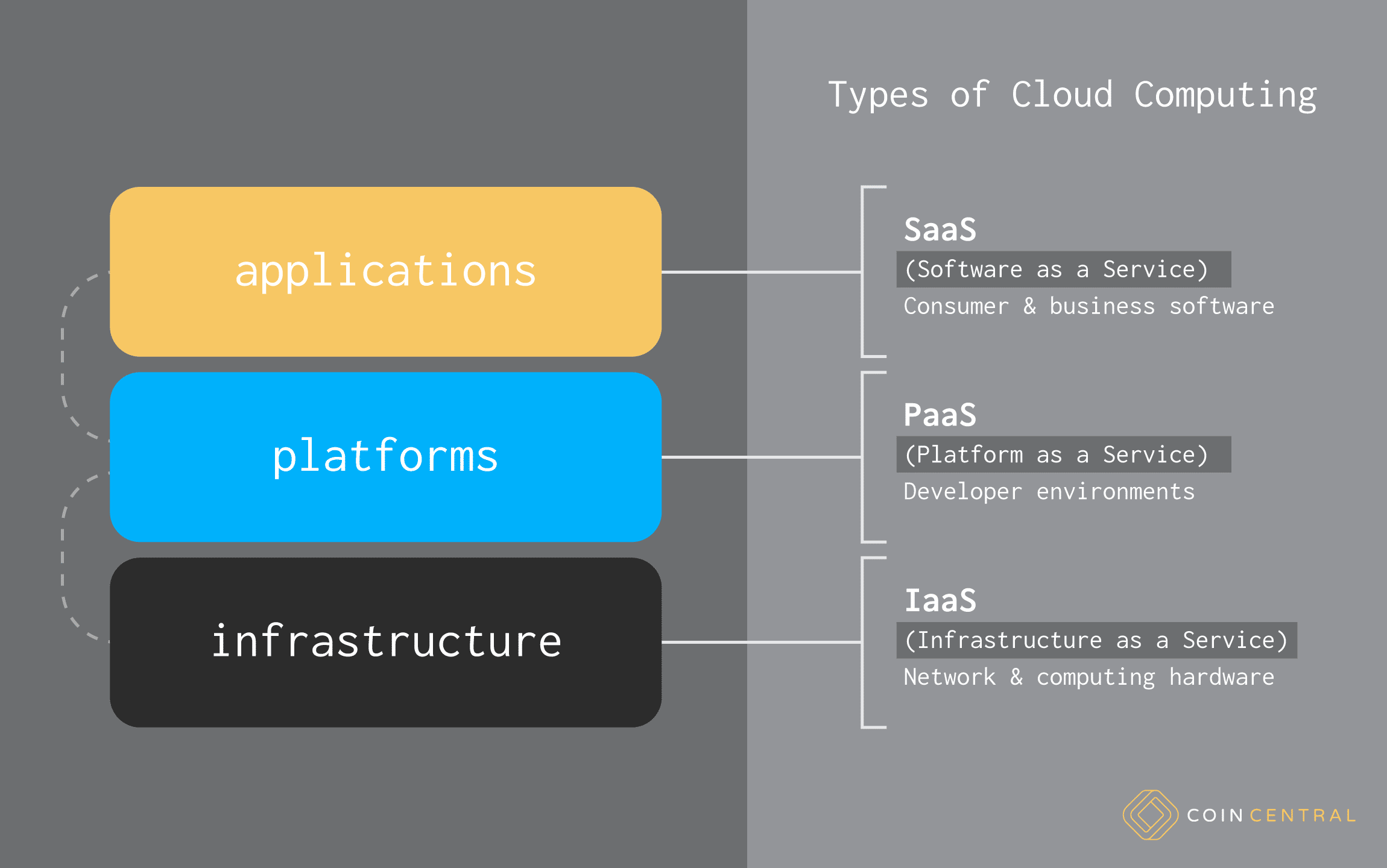The term cloud computing continues to mystify many as its definition seems to hang in the ether. The good news is, it’s not as overwhelming of a concept as you may think.
In fact, cloud computing is just a way to organize and outsource, two concepts humans have been championing for years.
Let’s try and alleviate some of the misunderstandings and unfold the types of cloud computing that make up the typical cloud stack. We’ll get back to that stack in a moment, but for now, just know there are three primary services that cloud computing provides.
Each of the three layers facilitates the one before it and stacks onto the other like a child’s toy blocks. The base of the stack is the infrastructure as a service (IaaS). Layer two is the platform as a service (PaaS), and the top of the stack is the software as a service (SaaS).
Take note that all three layers are a service. When you purchase cloud computing you are engaging with a service, not a product. Just like hiring a landscaper to mow your lawn, you don’t own the lawnmower after the work is done.
The Types of Cloud Computing
Side note: If you are this far and thinking to yourself, “Back up, what is cloud computing?” Take a moment to jump over to our cloud computing explainer. Afterward, you’ll have a much better feeling for what cloud computing is and how you are likely already using it every day.
Cliche’s aside, modern highways and ground-transport is a great simile to the types of cloud computing. We’ll use this framework to exemplify the basics of the three layers. Bear with us as we travel down the information super-highway!
Let’s jump into some more depth and explore what the types of cloud computing are and how they play nicely with each other.
Infrastructure as a Service (IaaS)
First up, the infrastructure.
It is easy to forget that there is a complex network of hardware working behind the scenes, which defines our digital experiences. On the surface, we consumers likely have a few devices. A few pieces of hardware that enable our digital lives.
Perhaps you have a router, a laptop, and a smart-phone, at least. These devices take up physical space in your life. The router in your basement, laptop on your desk, and smart-phone in your pocket.
The reality is that for any of these devices to work there are ten-fold more pieces of hardware behind the scenes. Servers, relay towers, uncountable miles of networking cables, data centers, and satellites are just a handful of examples.
Simply put, cloud computing infrastructure is similar to our roads and all that supports the healthy flow of motorized vehicles. Sure the streets, roads, and highways are important, but that is only a tip of the infrastructure iceberg. There are also street signs and lights, painted lines, organizational protocols, law enforcement, street lights, emergency services, concrete manufacturers, and countless acres of land.
All of these roadway components make up the minimum requirements for building more complex systems and applications. Similar to these required components, cloud computing’s IaaS provides the base needs for platforms and services to proliferate atop of.
A typical IaaS provider, like Amazon AWS or Microsoft Azure, will lease and sell their infrastructure cloud services to users. From there, users can experiment and build on scalable hardware solutions chock-full of cloud computing benefits.
Platform as a Service (PaaS)
Now that the hardware is in place, the next type of cloud computing is the platform as a service (PaaS) layer. Here’s where things get a little more intangible, and we begin to see the link between the infrastructure needed and the applications we want.
This bridging layer, the platform layer, is where the infrastructure gets merged with developer tools and programmer environments.
In terms of our roadway example, PaaS is to cloud computing as legislation is to a highway. Laws and rules on how we can build on and take advantage of our roadways are not unlike the protocols and programming languages that make-up the platform cloud services.
A blank roadway may be the infrastructure we need, but laws and norms are what enable roadways to evolve from a narrow use-case into a common good.
An empty server may also be the required infrastructure, but without protocols and programmer languages that server will have no applications to run.
Platform as a service is the layer that provides customers both the infrastructure and the developer toolkits they need to build scalable software and applications.
Currently, the lines between IaaS and PaaS are increasingly blurred as more IaaS companies are offering full suite platform solutions. An example of this is Amazon’s AWS services, which offers a full stack of cloud computing across all three layers. Providers like Amazon AWS connect the ecosystem of IaaS, PaaS, and SaaS so that users can efficiently scale into their needs.
[thrive_leads id=’5219′]
Software as a Service (SaaS)
Likely the most recognizable layer of the types of cloud computing, SaaS is where the applications and software are developed and delivered to the users.
From Netflix to Google Docs, software as a service typically refers to the cloud applications that most directly touch our lives. A defining feature of a SaaS application is that the lion’s share of the computing work is done remotely. In other words, your computer doesn’t necessarily store, run, or control the app you are using.
An easy illustration of a SaaS application is the evolution of word processing software. A decade ago, word processing applications like Microsoft Word were downloaded and installed onto each computer. For example, an office with ten computers would need to install ten separate copies of Microsoft Word for each machine to be able to use the software.
Each machine installed with Microsoft Word is sovereign. Personal settings, files, and works-in-progress were all isolated to your local computer. Moving files to another machine meant moving these manually.
Jumping to the present, the SaaS cloud service Google Docs removes those barriers by ultimately being a single copy of the application shared across all machines. In an office with ten computers, the software isn’t installed on any machine locally. Instead, each computer accesses Google Docs through the internet and typically through a web browser.
Personal settings, files, and works-in-progress are all stored remotely, away from your computer. This makes activities like moving between machines and sharing files infinitely easier. Not to mention the countless headaches that are avoided with a unified version (if you don’t feel the pain here, you’ve likely never had to update operating systems for a dozen working computers… and we wonder why corporations are so slow to update).
Pump the breaks, where’s the highway metaphor?
Let’s recap. Firstly, we have our infrastructure in the form of roads, signs and the required physical components as a stand-in to the hardware powering cloud computing. Secondly are the rules and legislation, which can empower us to build on the infrastructure. In the cloud, this second layer is the platform layer, where protocols and programming environments coupled with cloud infrastructure.
Lastly, we have the applications, or how us users can finally use the cloud services. On the highways and roadways, these are all other components that take advantage of the highway infrastructure and platforms. Trucking companies, Ford Motors, Uber, and Meals-on-Wheels are all applications that would be nearly impossible to implement without the previous two layers.
Like the cars, shipping companies and various services using our common roadways, SaaS is the final layer where developers scale and deliver products and services to users. Without IaaS and PaaS previous, SaaS would not be a consumer product and we would still be stuck in the single-software/single-machine paradigm.
Stacking the Types of Cloud Computing
Back to the stack. As mentioned, each type of cloud computing is a layer in the cloud stack. SaaS is on the top of the stack and is the most flexible and user-facing layer. Below that is the PaaS layer and subsequently the IaaS layer.
Each layer of the stack enables by the previous. For example, without the infrastructure layer, PaaS within a cloud environment would be improbable and definitely not a benefactor of the clouds scaling advantages.
Ultimately, it is easiest to understand the types of cloud computing as scalable outsourcing of your computing needs. Servers on demand, scalable developer platforms, and remote applications galore.
Never Miss Another Opportunity! Get hand selected news & info from our Crypto Experts so you can make educated, informed decisions that directly affect your crypto profits. Subscribe to CoinCentral free newsletter now.











